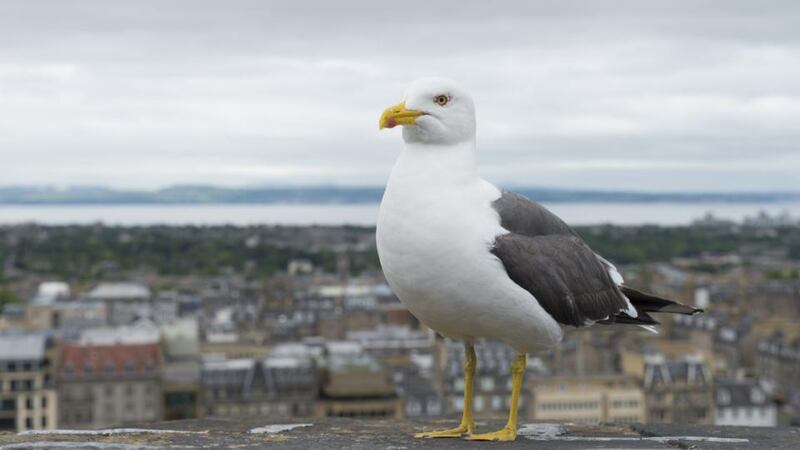Doesn't anybody read Jonathan Livingston Seagull any more? The protagonist of Richard Bach's hugely popular 1970s adult fable was an exquisitely ethereal creature, devoted to the higher things in life and repulsed by the vulgar obsession with food displayed by most of his species.
Now of course the good character of Jonathan Livingston is, biologically speaking, a load of sanitised old guano. No matter how many gulls you observe, you are very unlikely to find any paragons of spiritual healing. Their noisy, aggressive behaviour is more typical of the denizens of the Dáil bar on a late night than of students at a New Age self-improvement class.
But Bach, and more so his illustrator, did get one thing right about gulls: for reasons science has not yet quite explained, they are often extraordinarily beautiful to the human eye, both in flight and up close and personal.

I’ve sat on the breakfast terrace of a Moroccan hotel for hours, and watched how guest after guest becomes entranced by table-top encounters with yellow-legged gulls, a near relative of our herring gull. They rarely complained even when the birds seized the pastries off their plates. There’s something so pristine about that white breast plumage, something so enviable about the way the gull on your table can suddenly flip away and skim the Atlantic waves towards the distant horizon, which captivates many of us.
Not all of us, however, as the remarkable get-the-gulls campaign that has excited the midsummer media in recent weeks shows.
Suddenly, these birds have replaced dole fraudsters and love cheats at the top of the hate parade, right across these Atlantic islands of ours, if these reports are to be believed. There seems to be no vile crime that they have not committed.
One stole a pensioner's false teeth in Essex (while she was feeding more well-mannered birds!). Another was photographed while shop-lifting. A particularly malicious individual picked up an iPhone in the Botanic Gardens, and then dropped it into a pond, presumably because it couldn't find a buyer. Several of them have supposedly savaged sheep on a Kerry farm.
This kind of thing has not gone unnoticed in high places. Senator Ned O'Sullivan told our Upper House that they keep him awake at night with their raucous calls, and that they steal candy from babies. Even David Cameron found it necessary to pause from rooting out Islamist radicals from decent Muslim homes, and call for a nationwide "big conversation" about gulls, after a Yorkshire terrier was allegedly pecked to death by gulls in Cornwall.
Let’s start that conversation, then, by recognising that gulls can indeed be a nuisance to us, and occasionally cause serious damage. There’s nothing funny about losing a pet, or a phone, though the hysteria and, oh dear, gullibility, with which some of these events are being reported says more about slow news days than it does about a new threat to humanity.
So let's have that conversation calmly, without the drama of a script straight out of The Birds. Why are gulls becoming more of a nuisance, perhaps, than they once were? And what, if anything, should we do about it?
For starters, gulls are a nuisance to other species because, just like us humans, they are predators and carnivores, and also eat-anything-around-them scavengers. We don’t think of them as ‘birds of prey’, but you might think again if you watch online video footage of a big gull catching and despatching a small (wild) duck. That’s just the way evolution made them.
Unlike our own species, however, they are no more capable of cruelty or malice, at least as far as we know, than they are likely to be thinking the dreamy thoughts of Jonathan Livingston Seagull.
And if they are becoming more aggressive towards humans, then we need to understand how our own changing behaviour has changed theirs.
The surge in industrial fishing in the last century scattered carpets of discarded fish at sea and fish waste on harbour piers. The gull population exploded on the basis of this easy bounty. Cleaner, leaner fishing practices then forced these increased numbers to seek food elsewhere, on the rapidly expanding rubbish dumps around our cities, produced by consumer societies from the 1950s onwards. However, these gulls also suffered population crashes, probably due to botulism.
When we started closing the dumps, many gulls moved into the cities themselves, and became increasingly bold in scavenging food from humans.
There is an additional factor in Dublin. In the 1980s, the giant colony of 20,000 pairs of herring gull was minding its own business on Lambay Island, well away from the city, but it was deemed a threat to aviation flight paths. A massive cull was imposed, reducing the population to a few hundred nests. The surviving gulls had to go somewhere . . .
Expanding human populations inevitably lead to clashes with wild animals. It’s all about food – and territory. Attacks by mountain lions increase when American suburbia pushes out into wild tracts of land. Sharks attack surfers when they find them on their patch.
Gulls in our cities don't quite fall into these categories of risk. But before we rush to rash actions on the basis of sensationalised news stories, we need to gather a lot more scientific data to find out what the trends actually are, says Stephen Newton, Birdwatch Ireland's seabird expert.
If you are really concerned about the gulls nesting in your chimneys, the most useful thing you could probably do for now would be to log them on BirdWatch Ireland's current survey at https://www.surveymonkey.com/r/Roof_Nesting_Gull_Survey. It won't get you into the papers, but it will help inform a rational response to managing urban nature.
Paddy Woodworth is a journalist and author









